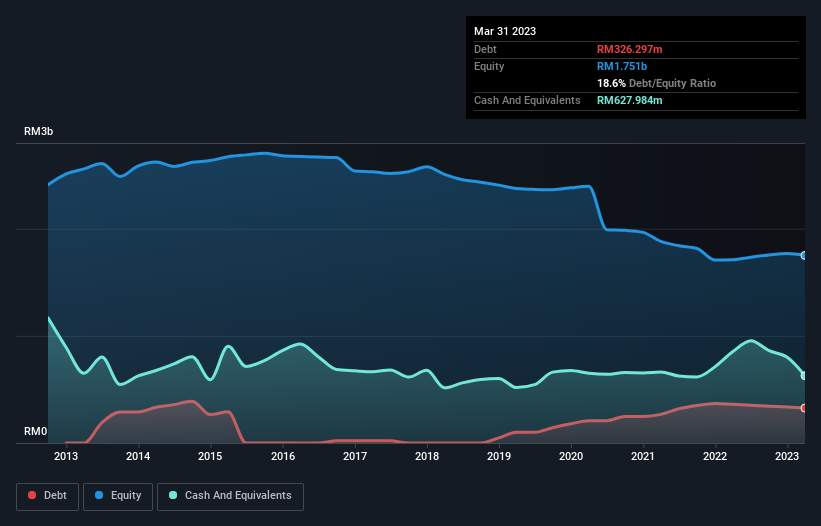- Malaysia
- /
- Energy Services
- /
- KLSE:MHB
Here's Why Malaysia Marine and Heavy Engineering Holdings Berhad (KLSE:MHB) Can Manage Its Debt Responsibly

Some say volatility, rather than debt, is the best way to think about risk as an investor, but Warren Buffett famously said that 'Volatility is far from synonymous with risk.' When we think about how risky a company is, we always like to look at its use of debt, since debt overload can lead to ruin. As with many other companies Malaysia Marine and Heavy Engineering Holdings Berhad (KLSE:MHB) makes use of debt. But is this debt a concern to shareholders?
When Is Debt Dangerous?
Debt assists a business until the business has trouble paying it off, either with new capital or with free cash flow. If things get really bad, the lenders can take control of the business. While that is not too common, we often do see indebted companies permanently diluting shareholders because lenders force them to raise capital at a distressed price. Having said that, the most common situation is where a company manages its debt reasonably well - and to its own advantage. The first step when considering a company's debt levels is to consider its cash and debt together.
See our latest analysis for Malaysia Marine and Heavy Engineering Holdings Berhad
What Is Malaysia Marine and Heavy Engineering Holdings Berhad's Net Debt?
The image below, which you can click on for greater detail, shows that Malaysia Marine and Heavy Engineering Holdings Berhad had debt of RM326.3m at the end of March 2023, a reduction from RM361.0m over a year. But on the other hand it also has RM628.0m in cash, leading to a RM301.7m net cash position.

How Healthy Is Malaysia Marine and Heavy Engineering Holdings Berhad's Balance Sheet?
We can see from the most recent balance sheet that Malaysia Marine and Heavy Engineering Holdings Berhad had liabilities of RM1.30b falling due within a year, and liabilities of RM294.2m due beyond that. Offsetting these obligations, it had cash of RM628.0m as well as receivables valued at RM937.3m due within 12 months. So its liabilities total RM33.8m more than the combination of its cash and short-term receivables.
Since publicly traded Malaysia Marine and Heavy Engineering Holdings Berhad shares are worth a total of RM920.0m, it seems unlikely that this level of liabilities would be a major threat. Having said that, it's clear that we should continue to monitor its balance sheet, lest it change for the worse. While it does have liabilities worth noting, Malaysia Marine and Heavy Engineering Holdings Berhad also has more cash than debt, so we're pretty confident it can manage its debt safely.
Although Malaysia Marine and Heavy Engineering Holdings Berhad made a loss at the EBIT level, last year, it was also good to see that it generated RM34m in EBIT over the last twelve months. When analysing debt levels, the balance sheet is the obvious place to start. But ultimately the future profitability of the business will decide if Malaysia Marine and Heavy Engineering Holdings Berhad can strengthen its balance sheet over time. So if you want to see what the professionals think, you might find this free report on analyst profit forecasts to be interesting.
Finally, while the tax-man may adore accounting profits, lenders only accept cold hard cash. Malaysia Marine and Heavy Engineering Holdings Berhad may have net cash on the balance sheet, but it is still interesting to look at how well the business converts its earnings before interest and tax (EBIT) to free cash flow, because that will influence both its need for, and its capacity to manage debt. Over the last year, Malaysia Marine and Heavy Engineering Holdings Berhad saw substantial negative free cash flow, in total. While investors are no doubt expecting a reversal of that situation in due course, it clearly does mean its use of debt is more risky.
Summing Up
We could understand if investors are concerned about Malaysia Marine and Heavy Engineering Holdings Berhad's liabilities, but we can be reassured by the fact it has has net cash of RM301.7m. So we don't have any problem with Malaysia Marine and Heavy Engineering Holdings Berhad's use of debt. There's no doubt that we learn most about debt from the balance sheet. However, not all investment risk resides within the balance sheet - far from it. For instance, we've identified 1 warning sign for Malaysia Marine and Heavy Engineering Holdings Berhad that you should be aware of.
When all is said and done, sometimes its easier to focus on companies that don't even need debt. Readers can access a list of growth stocks with zero net debt 100% free, right now.
New: Manage All Your Stock Portfolios in One Place
We've created the ultimate portfolio companion for stock investors, and it's free.
• Connect an unlimited number of Portfolios and see your total in one currency
• Be alerted to new Warning Signs or Risks via email or mobile
• Track the Fair Value of your stocks
Have feedback on this article? Concerned about the content? Get in touch with us directly. Alternatively, email editorial-team (at) simplywallst.com.
This article by Simply Wall St is general in nature. We provide commentary based on historical data and analyst forecasts only using an unbiased methodology and our articles are not intended to be financial advice. It does not constitute a recommendation to buy or sell any stock, and does not take account of your objectives, or your financial situation. We aim to bring you long-term focused analysis driven by fundamental data. Note that our analysis may not factor in the latest price-sensitive company announcements or qualitative material. Simply Wall St has no position in any stocks mentioned.
About KLSE:MHB
Malaysia Marine and Heavy Engineering Holdings Berhad
An investment holding company, engages in the provision of marine and heavy engineering solutions for offshore and onshore facilities, and vessels in Malaysia.
Adequate balance sheet and fair value.


